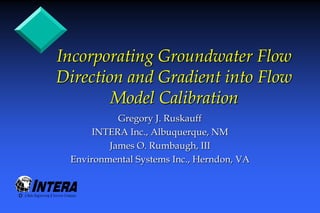
Model Care96
- 1. Incorporating Groundwater Flow Direction and Gradient into Flow Model Calibration Gregory J. Ruskauff INTERA Inc., Albuquerque, NM James O. Rumbaugh, III Environmental Systems Inc., Herndon, VA
- 2. Brief Review Van Rooy & Rosbjerg (1988) used plume to constrain flow model. Duffield et al. (1990) used advective particle tracking of plume to constrain flow model. Anderman et al. (1994) used advective particle tracking and inverse estimation for flow model. Guo & Zhang (1994) presented an inverse method that considers head and gradient .
- 3. What if you don’t have a plume? No plume, no analysis. Any surrogate we could use instead? More thorough use of head data? Assume that, as a first approximation, the shape of the potentiometric surface can be used.
- 4. Potentiometric Surface Shape Gradient gives steepness of surface. Direction computed from plane geometry. Pinder et al. (1981), Vacher (1989), and Cole and Silliman (1996) describe various approaches and computer programs. Not currently quantitatively included in calibration. Can be added to the calibration methodology.
- 5. Establishing Gradient/Direction Error Bounds Any measurement incorporates error: – field measurement error – scale effects – interpolation effects – error from unmodeled small-scale heterogeneity Unmodeled small-scale heterogeneity is probably the most difficult to quantify. Analytic solutions of Mizell (1980) address the error in direction and gradient in a 3-well monitoring network.
- 6. Approach to Setting Error Bounds Gelhar (1986) presented an approach that used analytic stochastic solutions to help set reasonable model error. In an analogous approach, Mizell’s solutions are used to help set reasonable gradient and direction errors for using this information in calibration. Solutions consider: – network size and orientation relative to flow – correlation scale – measurement error Assume all error from heterogeneity.
- 7. Analytic Solution Assumptions Networks form isosceles triangles. Infinite domain. Solutions obtained by pertubation analysis, may not be accurate for extremely heterogeneous media.
- 8. Characteristics of Mizell’s Analytic Solutions 2 solutions; first gives the expected value of the direction error, and the second gives the variance of the hydraulic gradient. Gradient solution difficult to use since it involves knowledge of variance of ln K. For values of the ratio of network scale to head correlation of <1 the error in direction and variance in gradient are bounded at a maximum. This reflects the fact that the head field is strongly correlated over short distances, and implies that less error will result in measuring the mean gradient from a larger network (Gelhar, 1991).
- 9. Bounding Direction Error- Stochastic Solution Practically,L/λ cannot be known. Upper bound is given 10 by assuming L/λ < 1. 1 Gives error in θ ± 21° 0.1 0.01 0.001 0.1 1 10 100 L/λ
- 10. Synthetic Problem 2D version of ModelCad sample problem. Initially run with homogenous properties to establish “truth”. 50 realizations of K generated and MODFLOW flow simulations done. Head calibration goals set, and each realization analyzed for heads and direction/gradient. Acceptable error estimated at 0.75 ft; giving a residual sum of squares of 8.5 ft2 or less.
- 11. Synthetic Problem Domain 3 sizes of networks Constant heads and drains Recharge 120x120 (every 2nd shown) Steady-state
- 12. Reference Conditions 26 22 18 14 10 6 feet
- 13. Bounding Direction/Gradient Error- Sensitivity Analysis Approach Using calibration goal head (0.75 ft) perform sensitivity analysis on direction/gradient errors. 85%, 44%, and 33% gradient errors for smallest to largest networks from perturbing by target error. 29%, 13%, and 11% from theory. 36°, 41°, and 13° for smallest to largest networks from perturbing by target error.
- 14. Head Calibration Goals 50 realizations run, 24 all simulations below Best Median 22 Worst RSS goal. Best, median, Computed Head (ft) and worst simulations 20 further analyzed. 18 16 14 14 16 18 20 22 24 Observed Head (ft)
- 15. Monte Carlo Results-Gradient 25% error bound
- 16. Monte Carlo Results-Direction Smallest network has largest θ variability Largest network has lowest variability Error in θ ± 21°
- 17. Ensemble Direction Errors 16 14 12 10 8 Smallest 6 Medium 4 Largest 2 0 Standard CV% Ave. Error SD Error Deviation
- 18. Solute Transport Analysis MT3D, constant mass loading Small network shows most variability (shown)
- 19. Real-World Test Truckee Meadows, Nevada, USA – 7 networks along plume path well matched by advective particle tracking – 3 networks had θ errors < 5° – 3 networks near upper bound (22°, 27°, 31°) – 1 error of 46° (furthest away from path)
- 20. Visualizing Gradient and Direction Errors Polar plot. True (yellow) and computed (red) directions plotted and connected with an arc. Percent error in gradient plotted as displacement away from origin.
- 22. Discussion Currently use post plots or contour maps of residuals to assess bias. Can get swamped by data. Doesn’t directly consider relations between wells. Is bias necessarily bad? If all heads off by 1 foot then direction and gradient will be correct. Worst head calibration does not have worst θ error or breakthrough.
- 23. Discussion- cont. Can be difficult to find meaningful combinations of wells. 6 5 5 6 7 Stream
- 24. Conclusions - 1 Significant direction and gradient errors can exist even in reasonably calibrated models. An upper bound on direction error from theory is about ± 21°. Sensitivity and Monte Carlo analysis suggests ~ ± 10° is readily achievable. Gradient errors of ± 25% common. Harder to set bounds on gradient error. Should be relative error.
- 25. Conclusions-2 Real world case show reasonable correspondance with theory and synthetic analysis in terms of achievable accuracy. Presented another tool for assessing calibration. Anisotropy not relevant, shape would still be the same. Use of head data alone still leaves room for substantial transport uncertainty
- 26. Incorporating Groundwater Flow Direction and Gradient into Flow Model Calibration Gregory J. Ruskauff INTERA Inc., Albuquerque, NM James O. Rumbaugh, III Environmental Systems Inc., Herndon, VA
